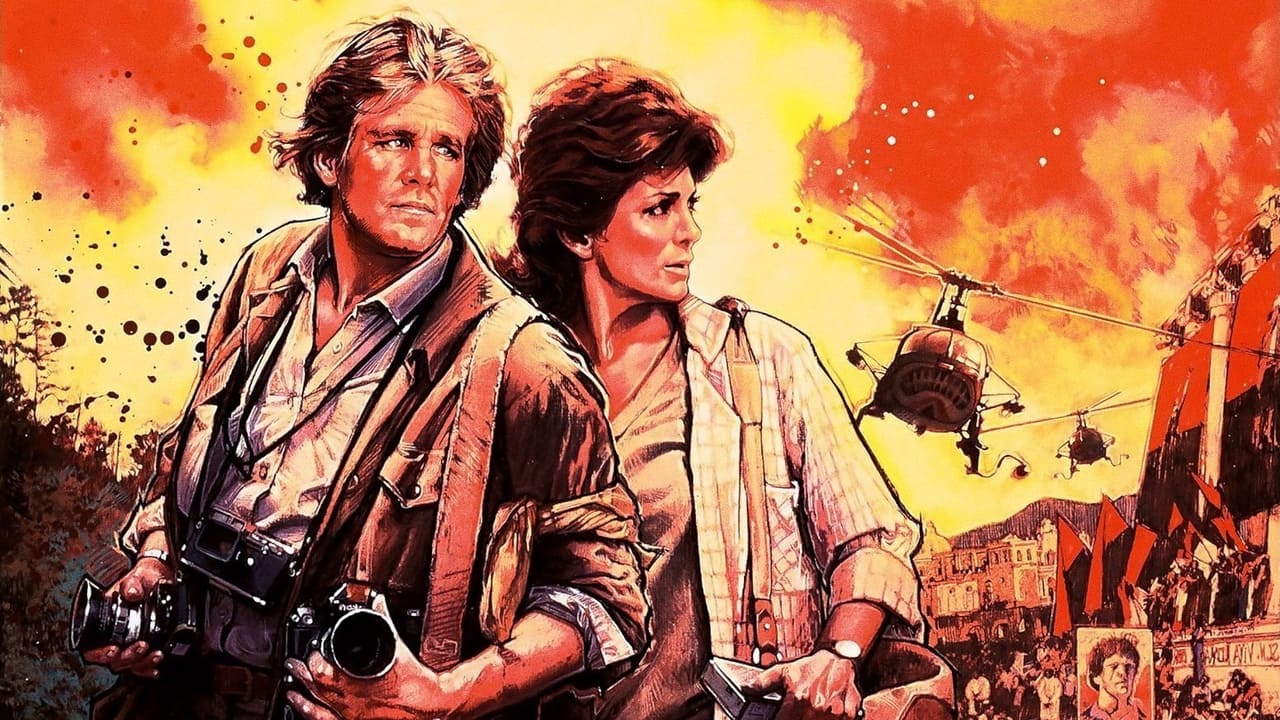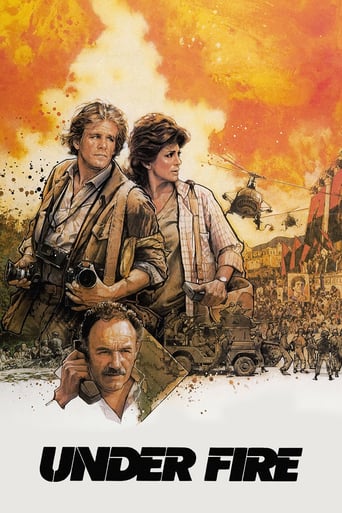

One of the best films i have seen
... View MoreThe performances transcend the film's tropes, grounding it in characters that feel more complete than this subgenre often produces.
... View MoreThis is a must-see and one of the best documentaries - and films - of this year.
... View MoreIt's simply great fun, a winsome film and an occasionally over-the-top luxury fantasy that never flags.
... View MoreThe filmmakers are successful in unfolding a specific moment in history when the Sandanistas overthrew the Somoza government in Nicaragua in 1979. But the film is slow paced and complicated by an unnecessarily drawn out romantic intrigue.Gene Hackman, Nick Nolte, and Joanna Cassidy are all good in their respective roles in journalism as a television broadcaster, a photographer, and a radio journalist. But the love triangle clouds the good work done in recreating the overthrow of Somoza.The film was shot in a gritty, realistic style, enhanced by the still photographs taken by Nolte's character Russell. Indeed, the photographer is coerced into forging a photograph that, when published, gives the impression that the leader of the rebels is still alive, when in fact Russell photographed a dead man.Two other essential characters are the nefarious fixer played named Marcel Jazzy, who strives to keep Somoza in power, and Ed Harris's character of Oates, a CIA mercenary, who is instrumental in counter-revolutionary tactics.While the film closes on a stirring parade of the victorious rebels, the final, memorable note is the curious presence of Oates on the scene, who vows to show up in Thailand as his next stop in covert ops.This was one of the finest films of the 1980s to expose the interference of the American government in Latin American affairs, and the meddling would continue later in the decade with the Iran-Contra affair, with illegal government actions that superseded Watergate in terms of felonious actions.
... View MoreIt's 1979. In Chad, war photographer Russell Price (Nick Nolte) meets American mercenary Oates (Ed Harris). Next he goes to Nicaragua which has been under various dictatorships for 50 years. Along with fellow reporters Alex Grazier (Gene Hackman) and Claire (Joanna Cassidy), he tries to capture the civil war to overthrow President Anastasio "Tacho" Somoza. They form a love triangle in the war zone. Russell and Claire are befriended by the rebels FSLN and brought back to their camp. They need Russell to take a picture of their dead leader Rafael to trick the world with a proof of life.All three lead as well as Ed Harris are near perfect. I love the war reporter club scene and the irreverent comradery. The murky world and the easy brutality are well presented. The locations are terrific and realistic. It's well made with great acting.
... View MoreIn the '80s Vietnam was history. Latin America was news. It's in this historical context that we must place Under Fire, amovie about the 1979 Nicaraguan revolution that overthrew President Somoza. It's a movie that is mostly forgotten but that I believe still matters today, not least because it's a well-crafted movie with a great cast.Under Fire is partly a fictionalised account of the story of Bill Stewart, an ABC News reporter gunned down by the Nicaraguan Army patrol at a road checkpoint. A cameraman filmed the execution and the footage caused a scandal back in the USA. The movie doesn't hide the irony that the life of one American journalist did more to turn public reaction against the government's support of the dictatorship than the lives of thousands of Nicaraguans. Like a Nicaraguan female doctor treating civilians says, "maybe we should have killed an American journalist 50 years ago." One can see why on its release the movie was accused, unfairly I think, of being Anti-American.The movie follows the photojournalist Russell Price (Nick Nolte), who trots around the globe, from war to war, taking pictures. We first meet him in Chad, risking his life to take photos of the rebels. With the way he puts himself in danger to get good photos we learn three things about him: he's fearless, he's a committed professional and he's been doing this a long time. It's also in Chad that the movie sets up a running theme throughout the movie: the uncomfortable comparison between journalists and mercenaries. In a darkly funny scene Price meets an old friend, Oates (Ed Harris), inside a truck full of rebels. Oates is a mercenary and thinks he's with the government troops. Price corrects him: he's in fact sitting next to rebels. Oates doesn't worry because the rebels only speak French. Oates also trots around the glob from war to war; like Price, he feeds on conflict. Neither takes sides; Oates does, of course, but only for monetary reasons; he doesn't really care about politics. And Price tries to remain impartial. It's obvious they've known each other for a long time. It's inevitable that their paths will cross in Nicaragua.In Nicaragua Price starts questioning his impartiality. "I think I finally saw one too many bodies," he says. As Price starts embracing the cause of the Sandinistas, the group opposed to Somoza's dictatorship, the movie becomes an interesting study of journalistic ethics, of information manipulation, and of the creation of myths to rouse people. To what extent is what we see reported the truth and not fabrications? How noble is it to fool people for a good cause? More than just agitprop, this movie opens up essential questions that any healthy democracy should regularly pose. Propaganda works both ways, of course, and the movie, quite pioneering, doesn't ignore the role PR companies play in whitewashing the criminal images of dictatorships.The movie is also a love triangle between Price, Alex Grazier (Gene Hackman) and Claire (Joanna Cassidy), both journalists too. Although I tend to dislike love stories in such movies because they always seem like tactics to keep people interested, as if politics weren't interesting enough, here the love relationships are quite subtle and understated, I'd even say adult. There isn't an overflow of sentimentality or an exhibition of romantic excesses or tropes. And the romance stays in the background of the political story.I can't find faults in any of the actors. Nolte is particularly enjoyable, with his gruff, rugged personality that slowly opens up to new ideas and feelings as he becomes involved with the Sandinistas. I had never seen Joanna Cassidy in a movie before, but I wonder why she isn't a better known start; she carried a lot of the movie herself. Hackman, who has a smaller role, was also solid. Harris was simultaneously funny and chilling. But of the actors in the minor roles Jean-Louis Trintignant stood out as the sensual French CIA agent, who hides his viciousness under a veneer of politeness and joie de vivre.In terms of technique, I'd place this movie on the same level as Costa-Gavras' better known Missing. Roger Spottiswoode creates some intense scenes of urban warfare and he makes palpable the atmosphere of fear and anticipation as the war leaves the countryside and approaches Managua, the capital. Particularly effective are the empty streets, punctuated by army checkpoints, as well as the unexpected, farway bullet noises in the distance, giving the impression that there's a whole lot of things going on outside the frame of the camera. Spottiswoode had the good luck of working with director of photography John Alcott (his credits include A Clockwork Orange, Barry Lyndon and The Shining). Each scene is framed in an interesting way. As an example, in the opening sequence rebels emerge from a deceptively desolate clearing. It's a neat trick.As important as Alcott's cinematography is Jerry Goldsmith's musical score. A chameleon of film music, Goldsmith could adjust his talent to suit any style, genre or mood. In here it makes extensive use of ethnic music and guitar by Jazz player Pat Metheny. The music contributes a lot to creating an exciting, suspenseful ambient and has become more famous than the movie itself.The movie is bloody and violent, and the violence is quite realistic, unexpected and brutal. Although the movie has a streak of dark humour, it never trivialises the violence itself. According to Spottiswoode, the studio produced the movie knowing that it'd be a commercial failure. They made the movie because they believed the story was worth telling. Thought-provoking and sometimes unpleasant, I think this is an under-appreciated gem that will hold the interest of anyone willing to give it a chance.
... View MoreAnd as we know now, most of the politics of this film as represented have been totally accurate. At the time Director Roger Spottiswoode made this film, we really did not know much of what was happening there, or what would happen "20 years from now" - As it is now 20, 30 years from those events, This film has turned out to be prophetic. This was an accurate depiction of the fall of the Somoza regime, and unfortunately the US took wrong sides in supporting the deposed government, support which was shut down via the first President Bush - But not forgotten as wrong is wrong forever. But as Ed Harris (Oates) said about that time right after Somoza fled: "It's a Free Country NOW"- Which was true at the time.Standing out, and probably the best role she has ever played and certainly the most comprehensive, not just a bit part: Joanna Cassidy ("Claire" - Bladerunner, The 4th Protocol, Ghosts of Mars ), is magnificent here, a woman showing great talent- being split between Husband Alex Grazier (Gene Hackman) and Photographer Russel Price (Nick Nolte) and she is torn between the two throughout the whole film. With other greats mixed in, Ed Harris as the Mercenary-for-Hire "Oates" who really has no idea who is hiring him as shown in the prelude- in Chad under hire from revolutionaries there- Hires himself out to the Somoza government as the film shifts to Nicaragua- And in contrast to Nolte's character, has no sense of right or wrong, just who is paying him.This film follows Price, first in Africa, then Nicaragua, who at first is looking for good photographs to tell the story of what is happening in that part of the world. As he continues, first he is accosted by Somoza Military as "Taking Too Many Photographs" and later finds his way to the camp of the revolutionary leader "Rafael" - At one point laying down his camera after a boy he takes a liking to is killed and picking up a machine gun. Jean-Louis Trintignant (Jazy) is the "Spy" and we eventually find out what his agenda is, perhaps his character does not even know- Is he helping Price and Claire or is he using them to find "Rafael" (Jorge Zepeda - "Collateral Damage" and "The Arrival")? This film is compelling enough to make you want to find out. Jack Palance Daughter Holly also makes an appearance as a journalist. Some very distinguished Latin American Actors are used, most recognizable is Jenny Gago.Filmed in Chiapas, Mexico, makes a convincing Managua, Nicaragua (And other Nicaraguan Cities)- The story is gripping and once engaged, is difficult for the viewer to walk away, this is one of those films which brings the viewer right into the story rapidly. Probably Spottiswoode's best effort. Does not use gratuitous violence, car chases, explosions although those are in the story but only as viable parts of the story line.
... View More